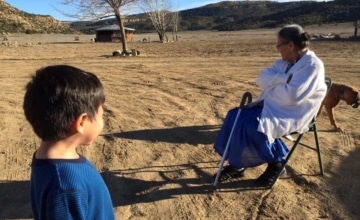The true extent of long-term effects of prenatal exposure to specific forms of opiates and related drugs such as methadone, buprenorphine, naloxone, or heroin is unclear; often times, multiple substances (including alcohol) are involved.
A new baby is a new beginning, promising new hope. For pregnant women struggling with opiate dependence, pregnancy and childbirth bring additional challenges as they navigate a variety of systems ranging from medical to social services. Watching a baby in withdrawal can be heart wrenching. Rates of heroin use and overdose deaths from opiates are continuing to rise, more so in rural areas. The epidemic is eating away at the fabric of society in far-flung little towns across the country that have limited access to specialty services.
The true extent of long-term effects of prenatal exposure to specific forms of opiates and related drugs such as methadone, buprenorphine, naloxone, or heroin is unclear; often times, multiple substances (including alcohol) are involved. While researchers tease out those details, there are certain things already known about infant and parent brains:
- Infant brain development is shaped by the relationship with an adult caregiver. A stable, predictable, attuned caregiver in the early years is key to healthy emotional regulation and attachment.
- Disrupted attachments with one’s child interfere with the baby’s ability to learn self-regulation, causing additional stress and increasing risk for abuse and neglect.
- Parenting, especially a new baby is, by nature, both rewarding and stressful.
- Interactions with medically fragile newborns are less rewarding and more stressful early on.
- Chronic substance use dulls neural reward circuitry and response to natural highs. Stress activates drug-seeking behavior.
- Babies going to a home where parents are struggling with addiction or those not going home at the time of birth itself are already experiencing early life stressors, and the baby is now at an increased risk for multiple adverse childhood experiences prior to age 18.
- Multiple adverse childhood experiences are risk factors for medical, psychiatric, and substance use disorders in adulthood and for disrupted attachments with one’s own offspring.
These interconnected, multigenerational facts tell us that the society will be shouldering the costs of medical, psychiatric, and substance use disorders for these children for several decades to come. As a society, we cannot afford it.
A variety of services are often involved in the journey of such families from pregnancy through school entry. Five points of intervention and corresponding recommendations are as follows:
- Pre-pregnancy/Inter-conception period:
- Actively inquire about plans for pregnancy at any primary care visit.
- Provide education regarding the effects of substance use in pregnancy.
- Support abstinence in those wishing to become pregnant.
- Pregnancy:
- Identify substance use by screening methods such as Screening, Brief Intervention and Referral to Treatment (SBIRT), T-ACE (Tolerance, Annoyance, Cutting down attempts, Eyeopener) in addition to urine drug screens and risk of substance use.
- Referral to Office-Based Medication Assisted Treatment programs for opiate addiction.
- Referral to groups such as NA/AA, substance abuse counselors, and therapists.
- At birth:
- Identification of substance exposure at birth by proper history and testing cord blood.
- Consistent and appropriate identification of children with Neonatal Abstinence Syndrome.
- Follow guidelines for medication and non-pharmacological management. (Kocherlakota, 2014).
- Follow federal and state guidelines for involving child protective services for establishing safety at discharge.
- Offer guidance about breastfeeding while in recovery as per recommendations. (Reece-Stremtan Marinelli & The Academy of Breastfeeding Medicine, 2015)
- Postpartum period:
- Ensure infant safety.
- Simultaneously support family’s needs for recovery and parenting, and infant’s medical needs.
- Assess and meet maternal needs and counsel regarding long-acting contraception.
- Infancy and beyond:
- Work toward early stability and permanency of placement for the infant.
- Referrals from birth to 3 years old.
- Infant and parent health care have to be identified and addressed.
At any point of contact, the strengths and needs of the family should be assessed and supported as needed—including safety, life skills, housing, financial, vocational, spiritual, legal, and environmental needs. As the family transitions between these points, information needs to be transferred legally, consistently, and in a timely manner across agencies.
Each of us has the ability to intervene in this cycle, sometimes even a simple gesture of kindness and empathy can go a long way in supporting recovery and parenting. For example, in Huntington, WV, the community has come together to address these issues, with the understanding no single organization can tackle the problem alone. “Healthy Connections” is a workgroup in that community with the mission of offering every child born into a household struggling with substance use an opportunity to build a healthy brain through healthy relationships and by supporting every family member in both parenting and recovery.
Beginning these conversations at an individual level can help kickstart policy changes at an organization level. Some resources to get started are noted below:
A Collaborative Approach to the Treatment of Pregnant Women With Opioid Use Disorders
Substance Exposed Infants In-Depth Technical Assistance (SEI-IDTA)
References
Kocherlakota, P. (2014). Neonatal abstinence syndrome. Pediatrics, 134(2), e547–e561.
Reece-Stremtan, S., Marinelli, K. A., & The Academy of Breastfeeding Medicine. (2015). Breastfeeding Medicine, 10(3), 135–141. https://doi.org/10.1089/bfm.2015.9992





